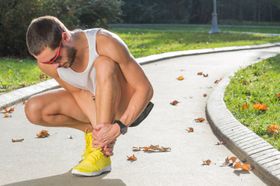Foot Supination: Diagnosis, Causes, and Treatment
Updated October 17, 2024

The feet play an essential role in everyday life. Unfortunately, when there is an issue with the foot, many people often leave them unaddressed until it becomes a severe problem. Foot problems, when they are left in this way, have been known to affect the quality of life. Alternatively, when issues with the foot are addressed, the quality of life improves.
One of the most common issues with the foot is supination.
What Is Foot Supination?
Foot supination occurs when the foot rolls on its outer borders when walking or running. Too much supination can cause pain and soreness in the muscles of the leg as supination forces the body to compensate for the change in gait mechanics in several ways, leading to imbalances and injuries. These injuries include knee pain, ankle sprains, foot problems, shin splints, and stress fractures.
Causes of Foot Supination
Generally, foot supination results from an imbalance in muscle action when walking. Common causes of this are:
- Inherited traits like limb length discrepancy, foot width, ankle stability, the shape of the foot arch.
- Rigid and tight-fitting shoes.
- Body malalignment.
- Previous injury to the ankle and foot.
- Sedentary lifestyle.
- Joint stiffness due to aging or arthritis.
- Prolonged standing.
Diagnosing Foot Supination
You could either diagnose foot supination by yourself or seek medical expertise to do so.
Self Diagnosing Foot Supination
There are 2 ways that you can diagnose yourself for foot supination.
1. Examine old shoes Check out the sole of your shoe to determine if there is any distinct pattern of wear. With supination, your shoes will wear down on the outer edges only. This is very different from the pattern of wear in people with normal gait, where the shoes wear out from the outer edge of the heel towards the center. Alternatively, you can conduct a tilt test. To do this, place your favorite walking or running shoes on a flat surface and observe the direction of tilt. If the shoes bend towards the outer edge, this may be a sign of foot supination.
2. Check footprints After wetting your feet appropriately, step onto a surface that will show your footprint clearly, such as a sheet of paper. You have supination if only a fraction (or none) of the arch is visible. With a normal degree of pronation, at least half of the arch is visible.
Medical Diagnosis (Gait Analysis)
A podiatrist or physical therapist can also prescribe a gait analysis test to determine if you have supination issues. For this test, you’ll need to walk or run on a specialized platform while the expert observes. The expert will also tell you if your shoes are right.
Even after self-diagnosis, you must carry out a gait analysis to determine the veracity of your self-diagnosis and get expert direction and treatment.
Treatment of Foot Supination
When issues with supination are noted, they must be addressed promptly. Otherwise, supination will lead to further pain in the ankle, knee, hip, and back; distorted gait; and other complications. The general approach to correcting supination is conservative while the goal is to address the imbalance and prevent complications.
Some of the common approaches are:
- Use of orthotics Orthotics with arch support are integral to the management of supination. Custom orthotics, in particular, are recommended by podiatrists. They provide maximum support for the arch and heel, helping to control the motion of the foot. You can order your custom orthotics online from Upstep.
- Proper shoes The right set of shoes will be incredibly lightweight, flexible, and provide enough cushion. These allow for sufficient ankle motion and foot and arch flexibility by providing adequate support. Also, ensure that the shoe fits properly and gives your toes enough room to move around.
- Retrain your posture A physical therapist can help retrain your walking posture. On your own, you can try to land gently on your feet when running or walking. Your aim should be to hit the ground midfoot instead of at the heel and avoid curving your toes. Usually, a short stride guarantees proper form compared to longer ones.
- Exercises Both stretching and strengthening exercises are useful for treating supination. While stretching will help address any tight tendons and ligaments, strengthening exercises will work on the muscles in your leg.
» Struggling with excessive supination? Check out our guide on how to correct foot supination
Importance of Proper Footwear
Whatever the case may be, the use of proper footwear can help mitigate most of the challenges that can result from excessive supination. Not only will the footwear prevent over supination, but it will also prevent long-term damage.
» Still not convinced orthotics can treat foot supination? Read the foot supination custom orthotics review








